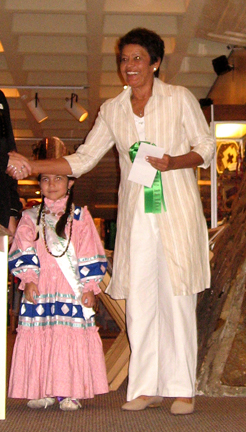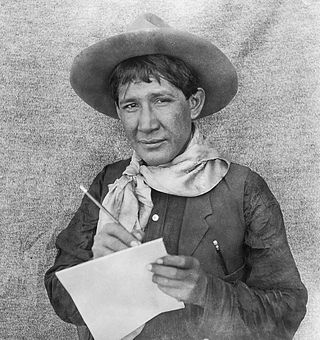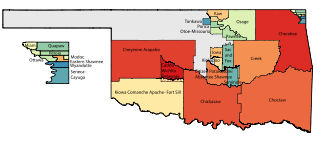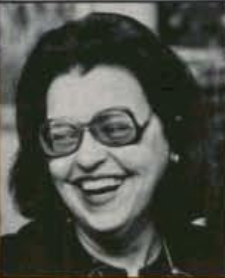
The Peoria are a Native American people. They are enrolled in the federally recognized Peoria Tribe of Indians of Oklahoma headquartered in Miami, Oklahoma.

Bacone College, formerly Bacone Indian University, is a private tribal college in Muskogee, Oklahoma. Founded in 1880 as the Indian University by missionary Almon C. Bacone, it was originally affiliated with the mission arm of what is now American Baptist Churches USA. Renamed as Bacone College in the early 20th century, it is the oldest continuously operated institution of higher education in Oklahoma. The liberal arts college has had strong historic ties to several tribal nations, including the Muscogee and Cherokee. The Bacone College Historic District has been on the National Register of Historic Places listings in Muskogee County, Oklahoma since 2014.
Albert Lee Harjo, born in the Muscogee (Creek) Nation in Hanna, Oklahoma, was a fullblood Muscogee artist.

Acee Blue Eagle was a Native American artist, educator, dancer, and Native American flute player, who directed the art program at Bacone College. His birth name was Alexander C. McIntosh, he also went by Chebon Ahbulah, and Lumhee Holot-Tee, and was an enrolled member of the Muscogee (Creek) Nation.
Fred Beaver was a prominent Muscogee Creek-Seminole painter and muralist from Oklahoma.
Walter Richard West Sr., was a painter, sculptor, and educator. He led the Art Department at Bacone College from 1947 to 1970. He later taught at Haskell Institute for several years. West is an enrolled member of the Cheyenne and Arapaho Tribes.
The Bacone school or Bacone style of painting, drawing, and printmaking is a Native American intertribal "Flatstyle" art movement, primarily from the mid-20th century in Eastern Oklahoma and named for Bacone College. This art movement bridges historical, tribally-specific pictorial painting and carving practices towards an intertribal Modernist style of easel painting. This style is also influenced by the art programs of Chilocco Indian School, north of Ponca City, Oklahoma, and Haskell Indian Industrial Training Institute, in Lawrence, Kansas and features a mix of Southeastern, Prairie, and Central Plains tribes.

Virginia Alice Stroud is a Cherokee-Muscogee Creek painter from Oklahoma. She is an enrolled member of the United Keetoowah Band of Cherokee Indians.

Earnest Spybuck was an Absentee Shawnee Native American artist, who was born on the land allotted the Shawnee Indians in Indian Territory and what was to later become Pottawatomie County, Oklahoma, near the town of Tecumseh. M. R. Harrington, an archaeologist/anthropologist, was touring the area documenting Native Americans, their history, culture and living habits. Interested in the religious ceremonies of the Shawnee which included the use of peyote, Harrington had ventured to the Shawnee Tribal lands. There he learned of Earnest Spybuck's artistic work and encouraged Spybuck in his endeavors. While Spybuck's work was obviously art, Harrington saw that he was illustrating detailed scenes of ceremonies, games, and social gatherings which could be used to illustrate many anthropological publications. Spybuck's work was received positively by both Native American and non-native artistic communities. Many of his works are now held by the Smithsonian's National Museum of the American Indian.

Oklahoma Tribal Statistical Area is a statistical entity identified and delineated by federally recognized American Indian tribes in Oklahoma as part of the U.S. Census Bureau's 2010 Census and ongoing American Community Survey. Many of these areas are also designated Tribal Jurisdictional Areas, areas within which tribes will provide government services and assert other forms of government authority. They differ from standard reservations, such as the Osage Nation of Oklahoma, in that allotment was broken up and as a consequence their residents are a mix of native and non-native people, with only tribal members subject to the tribal government. At least five of these areas, those of the so-called five civilized tribes of Cherokee, Choctaw, Chickasaw, Creek and Seminole, which cover 43% of the area of the state, are recognized as reservations by federal treaty, and thus not subject to state law or jurisdiction for tribal members.
Anita Fields is an Osage/Muscogee Native American ceramic and textile artist based in Oklahoma. She is an enrolled citizen of the Osage Nation.
David Emmett Williams was a Native American painter, who was Kiowa/Tonkawa/Kiowa-Apache from Oklahoma. He studied with Dick West at Bacone College and won numerous national awards for his paintings. He painted in the Flatstyle technique that was taught at Bacone from the 1940s to the 1970s.
Wendy Ponca is an Osage artist, educator, and fashion designer noted for her Native American fashion creations. From 1982 to 1993, she taught design and Fiber Arts courses at the Institute of American Indian Arts (IAIA) of Santa Fe and later taught at the University of Las Vegas. She won first place awards for her contemporary Native American fashion from the Santa Fe Indian Market each year between 1982 and 1987. Her artwork is on display at IAIA, the Los Angeles County Museum of Art, the Philbrook Museum of Art and the Smithsonian Institution's National Museum of the American Indian.
Jimmie Carole Fife Stewart is a Muscogee (Creek) art educator, fashion designer, and artist. After graduating from the Chilocco Indian School and taking courses at the University of Arizona, she earned a degree from Oklahoma State University and began working as a teacher. After a six-year stint working for Fine Arts Diversified, she returned to teaching in 1979 in Washington, Oklahoma. Primarily known as a painter, using watercolor or acrylic media, Fife-Stewart has also been involved in fashion design. Her works have been shown mostly in the southwestern United States and have toured South America. Having won numerous awards for her artworks, she was designated as a Master Artist by the Five Civilized Tribes Museum in 1997.

Valjean McCarty Hessing was a Choctaw painter, who worked in the Bacone flatstyle. Throughout her career, she won 9- awards for her work and was designated a Master Artist by the Five Civilized Tribes Museum in 1976. Her artworks are in collections of the Heard Museum of Phoenix, Arizona; the Philbrook Museum of Art in Tulsa, Oklahoma; the Southern Plains Indian Museum in Anadarko, Oklahoma; and the Wheelwright Museum of the American Indian of Santa Fe, New Mexico, among others.
Mary Adair is a Cherokee Nation educator and painter based in Oklahoma.

Jane McCarty Mauldin was a Choctaw artist, who simultaneously worked in commercial and fine art exhibiting from 1963 through 1997. Over the course of her career, she won more than 100 awards for her works and was designated as a "Master Artist" by the Five Civilized Tribes Museum in Muskogee, Oklahoma. She has works in the permanent collections of the Heard Museum, the Heritage Center of the Red Cloud Indian School and the collections of the Department of the Interior, as well as various private collections.

Solomon McCombs was a Native American artist from Oklahoma known for his paintings, murals, and illustrations.
Chief Carl Terry Saul (1921–1976) also known as C. Terry Saul and Tabaksi, was a Choctaw Nation/Chickasaw illustrator, painter, muralist, commercial artist, and educator. He was a leader of the Choctaw/Chickasaw tribe. He served as Director of the art program at Bacone College in Muskogee, Oklahoma, from 1970 until 1976.









